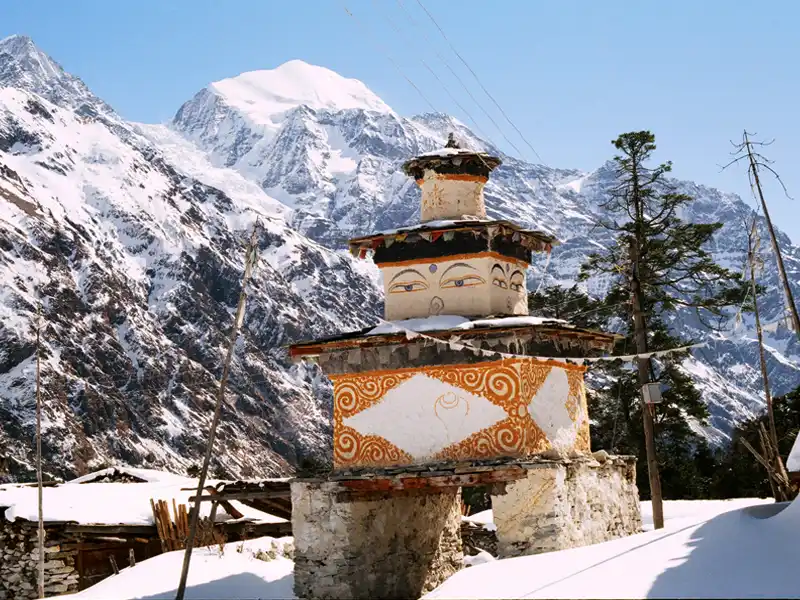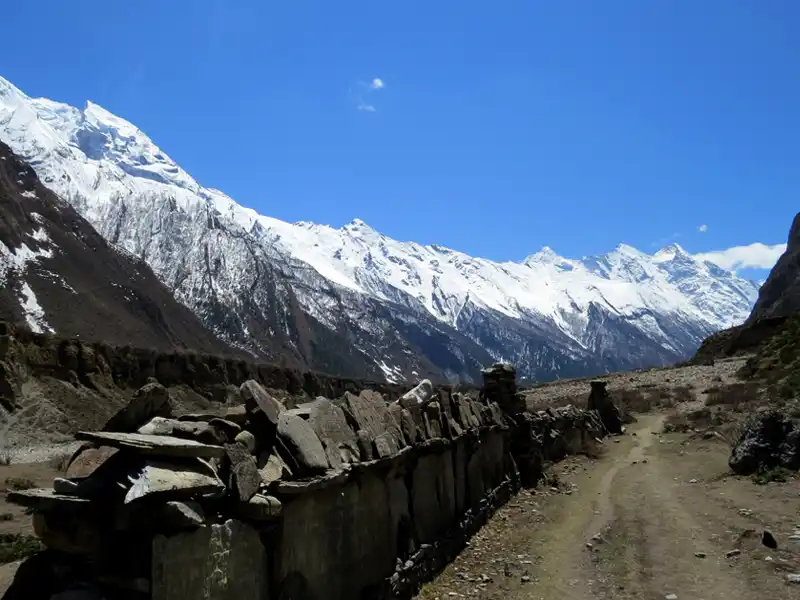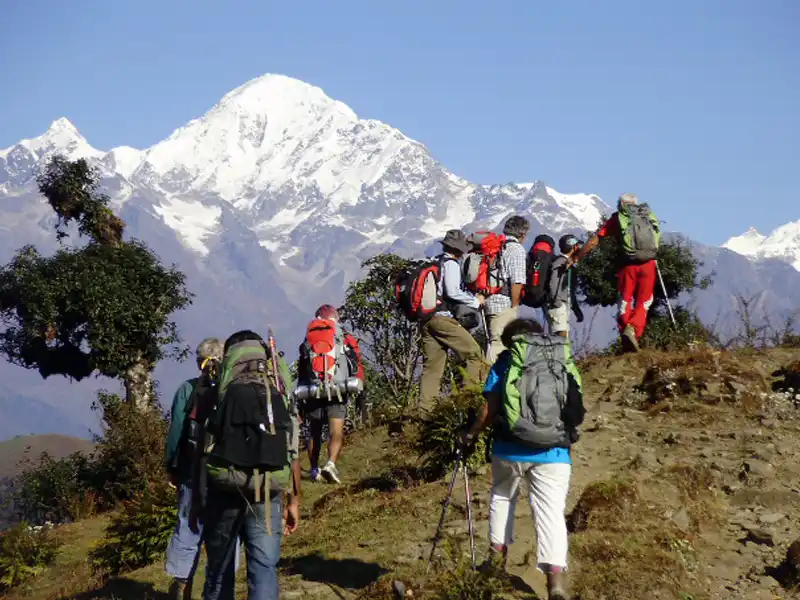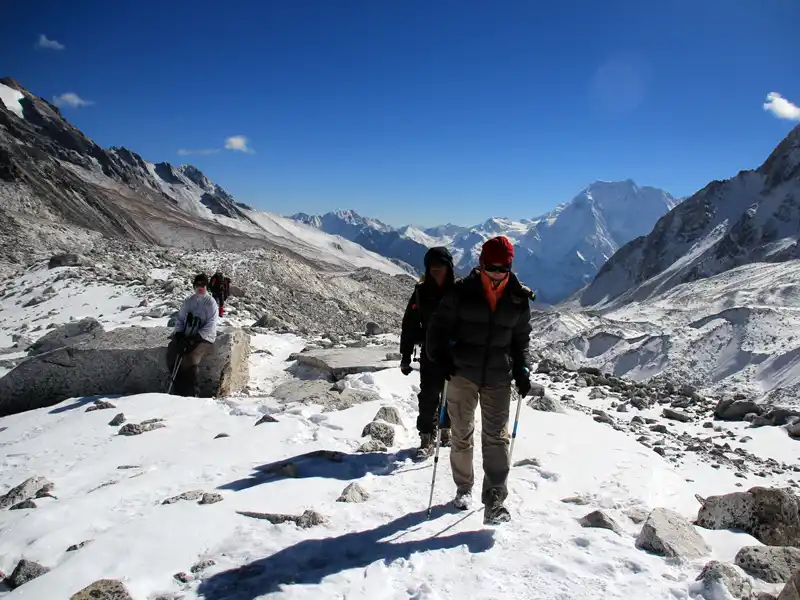Upon arrival in Kathmandu, you will be greeted by a representative from Manaslu Tours who will transfer you to your hotel. To start your journey on a high note, we will be hosted for a welcome dinner in the evening, featuring authentic Nepalese cuisine and a warm welcome drink.
- SWOYAMBHUNATH, also known as the monkey temple, is climbed by a long set of steps and has great views of Kathmandu.
- BOUDHANATH STUPA has many traditional Gompas hung with strings of multi-colored prayer flags; it attracts many Sherpas and Tibetans for the circumambulations of the stupa (koras)
- PASHUPATINATH is a Hindu temple with burning Ghats on the banks of the Bagmati River.
- KATHMANDU DURBAR SQUARE, which is one of the old capitals of the Kathmandu valley, has a blend of Hindu and Buddhist temples
Your day will begin early as you head to Kathmandu airport to catch a flight to Lukla. Assuming the flight departs on time, you will be treated to fine weather and stunning views of the Himalayan peaks during the flight. Once you land in Lukla, the trail starts at a Kani or gateway. As you set off, you'll begin walking down gently descending trails and pass by rolling farmlands that extend over a wide promontory with views overlooking the Dudh Koshi River canyon. The snow-capped peak at the head of the valley is Kumbila (5,716m), a mountain considered sacred to the Sherpa community. On the way to Phakding, you'll come across a huge boulder inscribed with Tibetan religious mantras, predominantly "Om Mani Padme Hum". After around 3 hours of trekking, you'll arrive in Phakding.
We will continue our trek northward, following the Dudh Koshi River until we reach Jorsale, where we will enter the Sagarmatha (Everest) National Park. From Jorsale, it's only a short walk to the confluence of two rivers, the Imja Drangpa (Imja Khola) and the Nangpo Tsangpo (Bhote Koshi). After that, we will begin a steep ascent that will take approximately 2 hours to reach Namche Bazaar, the main town in the Khumbu region. Namche Bazaar is a prosperous Sherpa town and an important trading center that hosts a weekly Saturday market. This leg of the journey will cover a distance of about 10.5 km/6.5 miles and take around 5 hours to complete on foot.
Today is a rest and acclimatization day, and it is particularly important as we will be gaining altitude quickly in the coming days. We will take this opportunity to allow our bodies to adjust to the high altitude and prevent altitude sickness. To aid the acclimatization process, we will embark on a 3-hour hike to Syangboche (3,760m), which offers a stunning panoramic view of Mount Everest and the surrounding Himalayan peaks. This hike will also provide us with an opportunity to immerse ourselves in the local culture and customs.
Today is a crucial day for acclimatization, and we won't be undertaking any serious trekking. Instead, we will descend to a slightly lower altitude in Thame, which is the birthplace of Tenzing Norgay, the first man to climb Mount Everest. We will spend some time exploring the local monastery and enjoying the beautiful scenery. This break will provide us with an opportunity to rest and allow our bodies to adjust to the high altitude. It's a necessary measure to prevent altitude sickness and ensure that we can continue the trek safely and comfortably.
After breakfast, we set out for Lungden. The terrain between Thame and Marlung is characterized by the alpine zone, with sparse vegetation. We appreciate the tranquility and seclusion of this rarely traveled valley. As we trek along the trail, we catch glimpses of the village of Yellajung on the other side of the Bhote Koshi. We pass through Tarngga village and enjoy breathtaking views of Kongde Ri as we make our way down the path. After about 45 minutes of walking on a gradually ascending trail, we reach Marlung. From there, we continue on foot for about an hour before ascending a small hill. Once we cross the water stream, we trek for another 2 to 3 hours until we finally reach Lungden.
On the big day, we have an early start as it will be a long and challenging trek. We'll be walking for approximately 5 hours to reach the pass, taking it slow due to the high altitude. After a brief break to appreciate the stunning beauty of the Everest Range and capture some photographs, we'll begin a challenging 3-hour downhill journey towards the village of Gokyo. This part of the trek will take us along the mesmerizing and picturesque Dudh Kunda, also known as the Milk Lake, which adds to the beauty of the journey.
After two to three hours of strenuous trekking, you'll reach the summit of Gokyo Ri. Despite the effort required to reach the top, you won't be disappointed, as the incredible views make it all worthwhile. From the summit, you'll enjoy a breathtaking panorama of Everest (8,848m), which will reveal more of its northern flank than seen from Kalapathar. Additionally, you'll be able to see Makalu (8,481m) further to the east and Cho Oyu (8,201m) towards the north, creating a mesmerizing and unforgettable sight. Take some time to relax and appreciate the stunning scenery before returning back to Gokyo Ri and resting after this challenging but rewarding adventure.
Today, you are embarking on a trek to Thaknak, which is also known as Dragnag. The trek begins by climbing out of Gokyo village and reaching a ridge. From there, you'll pass through the Ngozumpa Glacier and head towards the mountain on the other side. As you continue, you'll traverse along the edge of the mountain before descending to Thaknak. Throughout the trek, you'll be treated to breathtaking views of the Himalayas, including Cho Oyu and Gokyo Ri. While the trek may be challenging at times, the magnificent scenery will make it all worthwhile. Be sure to pace yourself as the altitude can affect your breathing and energy levels.
Today, we will be trekking to the Cho La Pass, which is one of the highlights of our trip. This is also going to be one of the most challenging days for us. Although the pass itself is not difficult, it is quite steep and involves a glacier traverse on the eastern side. We need to be careful as the trail is almost vertical and the rocks, glazed by ice, make it quite slippery for the trekkers. Our trail will take us through a ravine and a rocky path, climbing continuously up from Phedi. Along the way, we will trek alongside a frozen lake until we finally reach the top of the pass, which is beautifully decorated with prayer flags. However, we must also navigate through some crevasses before we can reach Dzongla, another stunning location that offers a complete view of Mt. Cholatse, Mt. Ama Dablam, Lobuche Peak, and the distant Pheriche village below.
After having breakfast in Dzongla, we will make our way to Gorak Shep. Initially, the trail descends easily for a while, followed by a few uphill and downhill sections until we reach Lobuche. Beyond that point, the trail becomes rockier and offers magnificent views of some of the world's highest mountains, including Mt. Everest, Mt. Nuptse, and Mt. Pumori, among others. The most fascinating part of today's trek is walking alongside the moraine of the Khumbu icefall, which we will do until we reach Gorak Shep.
We will begin early in the morning to catch the spectacular views from Kalapatthar, where we can witness the first light of day shining on Mt. Everest. We will be able to recognize some of the most famous peaks such as Lingtren, Khumbutse, Changtse to the east, and Mt. Everest situated between the west shoulder crest and Nuptse. After a two-hour ascent, we will reach Kalapatthar. From there, we will scramble to climb the rocky outcrop near the summit, which is marked by cairns and prayer flags. As we reach the top, we will sit and take in the unbelievable Himalayan panorama, wandering from one mighty massif to another. Our eyes will be treated to a feast of stunning views that will leave a lasting impression.
After a light lunch, we will begin our trek to Everest Base Camp, which is a round trip of approximately 4 to 5 hours to Gorakshep. Once we reach Gorakshep, we will cross the sandy flat and climb onto the lateral moraine of the Khumbu glacier. From there, we will ascend the side of the glacier for about two hours before descending onto the rocky glacial moraine. The trail will then wind up and down through fascinating ice seracs until we reach Everest Base Camp. Here, we will be rewarded with breathtaking close-up views of the Khumbu icefall. After taking a short break to soak in the views, we will retrace our steps back to Gorakshep. Once we arrive in Gorakshep, we will continue on our journey and walk for another 2 hours to reach Lobuche.
After breakfast at the lodge, you will begin your day by hiking through the Khumbu glacier in an easterly direction. As you cross the glacier and river, the trail will lead you up to the highest pass of this trip. It is important to note that there will be no tea shops or water sources along the way, so you will need to carry enough water to last you for the day. After a challenging climb to the summit, the trail descends steeply down to the Chukung valley, where your day will come to an end. You will be spending the night at the lodge.
Chhukung is not only a destination on its own, but it is also the starting point for the Island Peak Climbing. As we approach Chhukung, we are getting closer to the Himalayan civilization of the Khumbu Region. The Imja Khola river joins the Dudh Koshi River just a little above the Pangboche Village, which is home to a famous monastery believed to be the oldest in the Khumbu region. After our visit to the monastery, we descend through the alpine desert and back into the lush greenery of pine forests. The path then leads us on a steep uphill climb into Tengboche, where we will pay a visit to the famous Tengboche Monastery.
After leaving Tengboche, we will make a steep descent and follow the trail back along the Dudh Kosi River. As we pass through the forest, we will keep an eye out for local wildlife such as mountain goats, snow leopards, and colorful pheasants. After passing a Chorten, we will reach the army camp at Namche Bazaar, where we can take one last long look at the breathtaking views of Lhotse, the tip of Everest, and Tengboche. The final stretch of our journey will be a steep climb as we traverse the hillside, leading us to Namche Bazaar. Once there, we will enjoy a refreshing hot shower and a well-deserved, relaxed night's sleep in our comfortable room in Namche Bazaar.
As we make our descent, the trail becomes steep and rocky, so we need to walk slowly and carefully to maintain control over our shaky legs. However, as we cross the suspension bridges over the fast-flowing Dudh Koshi River and its tributaries, the terrain becomes more level and easier to navigate. Finally, we will arrive in Lukla, where we can take a moment to stretch our sore legs and reflect on the incredible experiences of the past couple of weeks. With everyone back safe and sound, we can look back on the trek with a sense of accomplishment and joy, with smiles on our faces as we celebrate the end of a fantastic journey.
We will take an early morning flight back to Kathmandu. Upon arrival, we can take some time to rest and relax throughout the day at our hotel. It will be a well-deserved break after our trekking adventure.
Today, we have a free day to explore the vibrant city of Kathmandu on our own. You may want to spend the day indulging in some souvenir shopping, wandering around the colorful streets and bazaars, or enjoying the local cuisine. You could also visit some of the popular tourist attractions in the city, such as the Bhaktapur, or Patan which showcase Nepal's rich cultural and historical heritage. Alternatively, you could engage in other activities like hiking, biking, or adventure sports, or simply relax and rejuvenate in one of the city’s many spas and wellness centers. Whatever you choose to do, make sure to soak up the unique sights, sounds, and flavors of this wonderful city.
Today, we will transfer to Kathmandu International Airport for our departure. After enjoying a hearty breakfast at the hotel, we will gather our belongings and make our way to the airport. We will ensure that we reach the airport well in time to complete all the necessary formalities and board our flight. Before we bid adieu to this enchanting country, take one last look at the breathtaking views of the Himalayas and take a moment to appreciate the warm hospitality and kindness of the Nepalese people. This marks the end of our tour, and we hope you had a memorable and enjoyable time in Nepal.
Everest Three Pass Trek cost on the website applies to groups 6–12 people. However, private trips for groups of two or more can be organized upon request. A group booking of 12 or more people can avail of a maximum discount with one free trip. Clients' travel date preferences can be accommodated, but the trek cost depends on factors such as group size, duration, accommodation type, and additional activities or services.
- Group Size: The cost of the trip will depend on the size of the group.
- Hotel Accommodation Category and Client's Budget: The cost may also vary based on the accommodation category and budget preference of the client.
- Itinerary Modification: Our trekking itinerary can be modified according to your time and requirements, and the cost will be adjusted accordingly.
- Additional Services: If you require additional services, the cost will be adjusted accordingly based on mutual understanding.
- Trekking Staff: The cost is also affected by the number of Trekking Guides, Assistant Guides, and extra porters required for the trip.
Please feel free to reach out to us with any questions or to book your trek.
Cost Includes:
- Airport pick up and drop off on a private vehicle.
- Full-day sightseeing in Kathmandu with English-speaking Tour Guide
- Hotel: 4 nights Hotel accommodation in Kathmandu at twin sharing a room on BB plan.
- Completely lodge trekking, including breakfast, lunch, dinner, and room during the trekking periods.
- Trekking Permit: Sagarmatha National Park and TIMS Card entrance fees.
- All the monuments and entrance fees in Kathmandu.
- Domestic tickets: Kathmandu to Lukla and Lukla to Kathmandu.
- Trekking Staffs: English Speaking Trekking Guide, Assistant Guide, and Porter (2:1 Porter)
- First aid and medical kits
- All government taxes and official charges.
- Accidental and medical Insurance of Nepalese staff.
Cost Excludes:
- Lunch & Dinner in Kathmandu.
- International air ticket.
- Nepal visa fees.
- Rescue/ emergence and insurance cost.
- Beverage and hard drinks and alcohol.
- Nepal entry visa fee and airport tax during the departure.
- Personal equipment and personal expenses.
- In case of natural calamities, i.e. political unrest, flight cancellation due to weather, landslides, etc., the extra charge should be borne by itself.
Please feel free for any queries. Q: What is the Everest Three Passes trek?
A: The Everest Three Passes Trek is a challenging trek in the Everest region of Nepal. It involves crossing three high passes (Renjo La, Cho La, and Kongma La) and visiting several of the region's most beautiful and remote valleys.
Q: How long is the Everest Three Passes trek?
A: The trek usually takes around 19–21 days, depending on your pace and itinerary.
Q: What is the difficulty level of the Everest Three Passes trek?
A: The Everest Three Passes Trek is considered a challenging trek as it involves trekking at a high altitude and crossing three high passes. Trekkers should have a good level of fitness and previous trekking experience.
Q: What is the best time of year to do the Everest Three Passes trek?
A: The best time to do the Everest Three Passes trek is from March to May and from September to November, as these months generally have clear skies and good weather. However, it is possible to do the trek in other months as well, although weather conditions may be more unpredictable.
Q: Do I need a guide for the Everest Three Passes trek?
A: While it is possible to do the Everest Three Passes trek independently, hiring a guide is highly recommended. A guide can help you navigate the challenging terrain, ensure your safety, and provide valuable insights into the local culture and environment.
Q: What permits do I need for the Everest Three Passes trek?
A: To do the Everest Three Passes trek, you will need a Sagarmatha National Park permit and a Khumbu Pasang Lhamu Rural Municipality permit. These can be obtained in Kathmandu or at the park entrance in Monjo.
Q: What kind of accommodation is available on the Everest Three Passes trek?
A: Accommodation on the Everest Three Passes trek ranges from basic teahouses to more comfortable lodges. The quality of accommodation varies depending on the location, with more basic facilities at higher altitudes.
Q: What should I pack for the Everest Three Passes trek?
A: Some essential items to pack for the Everest Three Passes trek include warm clothing, a good-quality sleeping bag, a waterproof jacket and pants, sturdy trekking shoes, sunglasses, a hat, and a first aid kit. It is also recommended to bring a reusable water bottle and a water purification system.
 Everest 3 High Passes Trekking
Everest 3 High Passes Trekking Most Popular
Most Popular 


